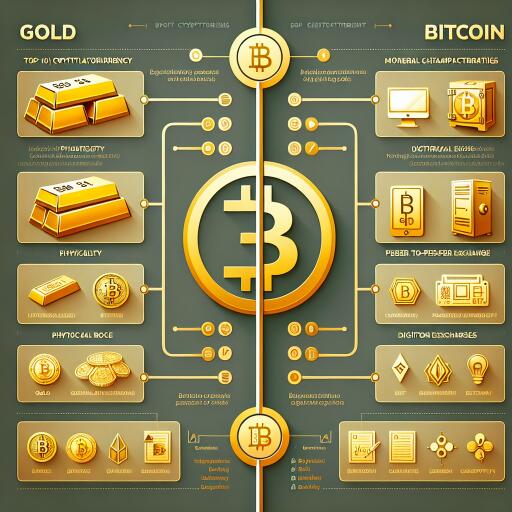Exploring the Future of Money: Gold versus Bitcoin
In the evolving landscape of monetary assets, the debate between traditional gold and digital currency Bitcoin is intensifying. This comparative analysis delves into ten critical monetary characteristics to discern which of these two assets might hold the upper hand as a superior means of preserving value across time and space.
Scarcity: The Battle of Finite Resources
The allure of gold and Bitcoin stems largely from their scarcity. Gold, with an estimated 6.8 billion ounces above ground and an annual production of roughly 118 million ounces, has intrigued humanity for millennia. Its future supply remains a subject of speculation. In contrast, Bitcoin presents an unprecedented model of absolute scarcity in the monetary realm – its supply capped firmly at 21 million units, with over 93% already in circulation. This feature of Bitcoin creates a unique scarcity akin to owning a specific fraction of the global supply, fundamentally differentiating it from gold’s relative scarcity.
Hardness: The Resistance to Debasement
Monetary hardness, or resistance to production and consequent debasement, marks a vital aspect of any currency’s long-term viability. Historically, gold’s tangible nature made it the benchmark for a “hard” asset. Yet, the advent of Bitcoin introduces a paradigm shift. Thanks to its digital architecture and predetermined issuance schedule, Bitcoin’s supply remains impervious to demand-induced inflation, essentially redefining the concept of monetary hardness. As Bitcoin’s protocol dictates supply halving events, it is on course to outpace gold as the hardest asset known to man.
Liquidity: The Scale of Market Participation
Liquidity, or the presence of a broad and active market, plays a critical role in the utility of money. Gold, with its millennia-long headstart, boasts a vast market capitalization. Bitcoin, though considerably younger and with a smaller pool, is experiencing rapid growth. This disparity highlights gold’s current advantage in liquidity, albeit with Bitcoin rapidly closing the gap.
Portability: The Ease of Movement
From the perspective of portability, Bitcoin unmistakably trumps gold. The logistical nightmares and security risks associated with transporting physical gold stand in stark contrast to the digital ease with which Bitcoin traverses the globe. This unparalleled portability elevates Bitcoin far beyond traditional valuables, revolutionizing the concept of asset transfer.
Verifiability: Assurance of Authenticity
In an era where authenticity matters more than ever, verifying the legitimacy of a monetary asset becomes paramount. Gold’s physical nature necessitates intricate verification processes, whereas the intrinsic properties of Bitcoin allow for instantaneous and tamper-proof validation. This distinction underscores Bitcoin’s superior capability in ensuring the genuineness of transactions and holdings.
Fungibility and Privacy: The Dual Pillars of Discretion
Fungibility and privacy represent critical aspects of any monetary system, allowing for untraceable and interchangeable transactions. Gold enjoys innate privacy due to its physical form; however, Bitcoin, despite its public ledger, offers innovative solutions for enhancing transaction anonymity. Advances in technology promise to further solidify Bitcoin’s position in this regard, hinting at a future where digital currency rivals or surpasses the discretion afforded by gold.
Divisibility: Catering to Transactions of Any Size
Bitcoin’s divisibility vastly outshines that of gold, breaking down into units as small as one hundred millionth of a Bitcoin. This feature enables transactions across an extensive range of values, from the minuscule to the monumental, providing flexibility unmatched by gold’s physical constraints.
Scalability: The Path to Universal Adoption
The question of scalability remains crucial as either asset vies for global dominance. Gold’s reliance on third-party intermediaries for large-scale transactions presents inherent vulnerabilities. Bitcoin, through innovations like the Lightning Network, demonstrates a viable path towards handling global transaction volumes directly, bypassing the need for centralized control. This aspect not only facilitates widespread adoption but also ensures Bitcoin’s resilience and decentralization.
As we stand at the confluence of tradition and innovation, the comparison between gold and Bitcoin reveals a shifting paradigm in the concept of money. Gold, with its storied history, provides a legacy of stability and universal recognition. Conversely, Bitcoin’s technological foundation offers an evolutionary leap in terms of scarcity, portability, divisibility, and security. While gold holds its ground as a timeless reserve of value, Bitcoin emerges as a formidable contender, redefining the attributes of a modern monetary asset.
The journey towards determining the ultimate form of money continues, with both assets showcasing unique advantages. As the digital age progresses, the potential for Bitcoin to ascend as a predominant medium for storing and transferring value cannot be understated. The interplay between these monetary titans will undoubtedly shape the future landscape of global finance.










